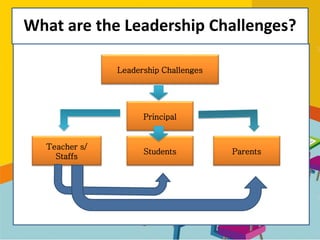Classroom Management Presentation by Nursheha Mohd Hadzri (Master Education)
- 1. EDM 703 Instructional Leadership Chapter 7: Classroom Management NURSHEHA BINTI MOHD HADZRI M.Ed. Management and leadership UiTM Malaysia Resource: Instructional Leadership by Anita and Wayne 3rd Edition
- 2. Classroom Management : All of the things that a teacher does to organize students, space, time and materials so that instruction in content and student learning can take place.
- 3. Leadership Challenge’s TeachersStudents What are the Leadership Challenges? Leadership Challenges Principal Teacher s/ Staffs Students Parents
- 4. Leadership Challenge’s TeachersStudents What are the Leadership Challenges? Students walk around the classroom during lessons. Students interrupt while teacher is attending to one group. Some students listen , but ask a million questions out off the topic / unrelated. Challenging students
- 5. Leadership Challenge’s TeachersStudents What are the Leadership Challenges? Teachers try hard to control class, but are completely overwhelmed. Teachers desperately try to get control of the situation. Students ask challenging questions. Teachers feel anxious and nervous during lessons. Challenges Faced By New Teachers
- 6. Organizing the Learning Environment How to organize the learning environment? 1. Gain their (students) cooperation Dealing affectively with misbehavior Different activities require different managerial skills. Friendship and status with peers 1. Manage the learning environment • More time for learning -allocated time -engaged time -academic learning time • Access to learning • Management for self-management
- 7. Creating a Positive Learning Environment 1. Rules and Procedures • Procedure • Rules -Rules Elementary School -Rules Secondary School • Consequences 2. Planning for computer uses
- 8. Creating a Positive Learning Environment Rules and Procedures a) Procedures Administrative routines Student movement Housekeeping Lesson routines Teacher-student interactions Student-student interactions
- 9. Creating a Positive Learning Environment 1) Rules and Procedures b) Rules Statement specifying the expected and forbidden actions in class. i. Rules Elementary School ii. Rules Secondary School
- 10. Creating a Positive Learning Environment Rules and Procedures b) Rules Elementary Secondary • Be polite and helpful • Respect other’s property • Listen when others are speaking • Do not hit, shove, or hurt others • Obey all school rules • Bring required materials to class • Seat and ready to work when bell rings • Respect and be polite to everyone • Respect other people’s property • Listen and stay seat while others is speaking • Obey all school rules
- 11. Creating a Positive Learning Environment Rules and Procedures c) Consequences 1. Separate the deed from the doer-the problem is behavior not the students. 2. Highlight to students they have power to choose their actions and avoid losing control. 3. Encourage students reflection and problem solving- avoid teacher lecturing. 4. Help students identify problem and advise them.
- 12. Creating a Positive Learning Environment 2. Planning for computer Uses Management issues 1. Provide convenient access 2. Be prepared 3. Create trained expert to help with computer 4. Develop system for using computer 5. Plan the arrangement of the computer 6. Experiment with other model for using computer
- 13. Getting Started: The first Weeks of class 1. Effective Classroom managers for Elementary Students 2. Effective Classroom managers for Secondary Students 3. Creating a learning community
- 14. Getting Started: The first Weeks of class 1. Effective Classroom managers for Elementary Students • First day well planned & organized • Deal with student’s main concerns • Teach rules & procedures • Whole group focus • Appeal to student interests • Monitor the whole group • Stop misbehavior quickly
- 15. Getting Started: The first Weeks of class 2. Effective Classroom managers for Secondary Students • Establish rules, procedures, and standards • Clearly communicate standards for work • Consistently enforce expectations • Monitor students closely • Deal with rule infractions quickly • Shorter work cycles for lower ability students • Monitor student progress carefully
- 16. 1. Creating a learning community Getting Started: The first Weeks of class Creating a learning community Cooperative community Constructive conflict resolution Civic values
- 17. Maintaining a Good Learning Environment 1. Encouraging Engagement 2. Prevention Is The Best Medicine With-it-ness Overlapping and Group focus Movement Management Students Social skills as prevention Caring relationship: Connections with School
- 18. Dealing with Discipline Problems Ways to stop misbehavior Make eye contact Try verbal hints Aware of negative effects Remind the students Ask the students to state the correct rule or procedure Tell the students in a clear and assertive way to stop misbehavior Offer a choice
- 19. Dealing with Discipline Problems 1. Special problems with Secondary Students 2. Special programs for Classroom Management Group consequences Positive behavior Supports
- 20. Dealing with Discipline Problems 1. Special problems with Secondary Students Work not completed: -Teach students how to use a daily planner -Keep accurate records -Enforce established consequences -Do not grade on ‘the benefit of the doubt’ Continue to break rules: -Seat student away from other students -Catch them before they break the rules -Enforce established consequences -Don’t accept promises
- 21. Dealing with Discipline Problems 2. Special programs for Classroom Management Group consequences -recommended for situations in which students care about the approval of their peers. Positive behavior Supports -for students with disabilities and those who are being considered for special education service.























